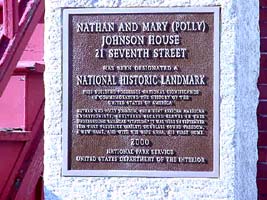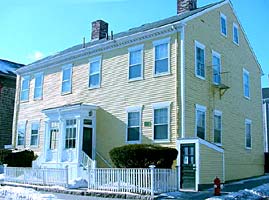Nathan and Polly Johnson


On September 17 or 18, 1838, a young man of color named Frederick Johnson (Frederick Augustus Washington Bailey in slavery) arrived with his new wife Anna at 21 Seventh Street, home of Nathan and Mary Johnson. The front part of the house had not yet been built, and the couple lived in the older, now rear, section. Nathan Johnson paid the freight charge for the penniless couple's baggage and took them in. Because there were many Johnson families of color already in the city, Frederick wrote, "I gave Mr. Johnson the privilege of choosing me a name." From then on he was known as Frederick Douglass, one of the most powerful and persuasive advocates of equal rights in 19th-century America.
The Johnsons were among the best known and most active of the black abolitionists in New Bedford. Nathan Johnson had involved himself with fugitive slave issues in the city since at least 1822. How and when he came to the city is not precisely known, nor is his status. Johnson was a delegate to most of the early conventions of free colored people in the United States, but he may have been a fugitive himself. Like Joseph Ricketson, Johnson is known to have sheltered others who escaped slavery in his home. Twenty-one Seventh Street is now the headquarters of the New Bedford Historical Society, dedicated to preserving and interpreting the history of people of color in the city and region.

The frame, double house next door to the Johnsons' home also belonged to them. Built in 1785, it had been the first meetinghouse of the Society of Friends in New Bedford and was moved diagonally across Spring Street by 1822, when Quakers built their second, brick meetinghouse on its site.
Excerpted from "The Underground Railroad: New Bedford," published by the National Park Service.
| Previous | New Bedford Field Trip: Home | Next --> |





